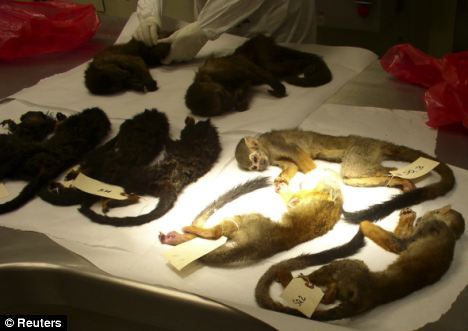The wooden crates used to transport non-human primates are dark, and cramped, with small slots for food and ventilation. In what can only be described as a terrifying ordeal, monkeys are subjected to horrendous conditions including unfamiliar noise, inadequate food and water supplies, poor ventilation and temperature extremes. Having first been either ripped violently from the wild or bred in terrible foreign breeding facilities, their journey only ends in hell.
The International Primate Protection League report states an astonishing 18,934 apes and monkeys were imported to the U.S in 2013 alone for use in medical experiments. The notorious laboratory, Covance Research Products Inc., is the number one importer, but lesser known is a Japanese based company called, SNBL USA, Ltd. (Shin Nippon Biomedical Research Labs). Based in Everett, WA., SNBL is the second largest importer of monkeys for vivisection.
On October 1, 2013, a shipment of 840 macaque monkeys arrived at Houston Airport, Texas from Cambodia, headed to two SNBL laboratories. The crates contained 420 males and 420 females jammed into 222 cages. Most of the animals were between 2.5-6 years old.
By the time half of the shipment of monkeys got to the Shin Nippon Labs in Washington, 25 animals had died or had to be euthanized. A report obtained by Stop Animal Exploitation NOW! states that the monkeys "exhibited signs of hunger and thirst," and death was likely caused by dehydration and starvation.
After a significant undercover investigation, the British Union for the Abolition of Vivisection released a report in 2008 stating monkeys captured in Cambodia, specifically macaques, suffered enormously, and were kept in cruel conditions before being exported.
Apart from the obvious suffering these monkeys endured something about the records obtained by SAEN just doesn't add up.
The drive from Houston, TX to Everett, WA is approximately 33 hours. The summary of transportation states that the drivers checked all the animals on their way to Everett at 8 p.m on Oct. 1, and all were doing fine. By the next stop at 11:03 p.m they noticed the first signs that one animal appeared weak but seemed to improve after being given fruit and Gatorade. At the next stop at 3:24 a.m the monkey still looked weak.
By 7:40 a.m. on Oct. 2 the first monkey was found dead in the trailer and two more monkeys were exhibiting signs of weakness. By the time the truck arrives in Everett on Oct. 4 at 6:50 a.m five monkeys were dead, and several others were so weak they had stopped eating and drinking.
During transit, it is incredibly hard to tell the condition of any monkeys in crates. Even experts in the field find this task difficult as the monkeys are terrified and are not exhibiting normal behavior. They are also being given food they are not used to and may not even recognize enough to eat. I doubt there is Gatorade in the Cambodian jungles. Obviously, the SNBL monkeys were not treated well and were completely mishandled somewhere along the line. But this is not an isolated incident. The BUAV 2008 report also states that as many as eight out of ten monkeys imported dies before it gets to the destination laboratory.
In April 2012, Robert Matson Conyers was charged with 10 counts of animal cruelty after 15 out of 25 monkeys he was importing died of starvation and thirst in transit. That particular trial lasted a week with Conyers being found not guilty. When I asked some of the jury why they had found him not guilty with such overwhelming evidence, they said they felt that anyone can "forget" to feed animals and, as there were multiple hands the crates went through, it was not "fair" for Conyers to shoulder the blame. The case, although heroically fought by the Los Angeles DA, smacked of speciesism on the part of the jury and Conyers, who showed zero remorse and an amazing arrogance throughout the trial.
During the trial, I learned a lot. I discovered that although there are many USDA inspectors who care deeply about the animals being traded internationally, most imports get rubber-stamped. I highly doubt either the CDC or the USDA had the manpower or time to physically inspect all 222 crates imported by Shin Nippon.
Most of the monkeys SNBL is importing are from a breeding facility in Cambodia. Cambodia is the third largest exporter of monkeys for experiments. China is the first and Mauritius is the second. Macaques make up the majority of monkeys exploited followed closely by crab-eating, rhesus, pig-tailed, and long-tailed monkeys.
William Ralph Inge once said, "We have enslaved the rest of animal creation, and have treated our distant cousins in fur and feathers so badly that beyond doubt, if they were able to formulate a religion, they would depict the Devil in human form." When it comes to the use of our primate cousins in biomedical research, not a truer word has ever been spoken.
It is beyond unconscionable that this disgustingly cruel trade is allowed to continue. SAEN has filed an official complaint with the U.S Department of Agriculture, who could fine SNBL up to $10,000 per animal death if they are found to be in violation of the Animal Welfare Act. Lets hope SNBL are made to pay a meaningful penalty. It is the only way companies like this who make huge profits off the backs of animals will take notice.
For more information please visit:http://www.all-creatures.org/saen/wa/res-fr-wa-snble.html


